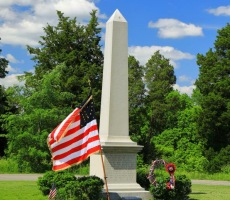Experience the sound of artillery, horses racing across the battlefield, and musket fire in a living history event depicting the Battle of Perryville. The Perryville Battlefield State Historic Site will hold an anniversary celebration on October 8-9, 2022 to commemorate the 160th anniversary of the Battle of Perryville.
Come and explore Civil War camps with us. You’ll be able to speak with Living History Historians about the events of the Civil War. Listen to one of the scheduled lectures and take a tour of the battlefield. Visit the Perryville Battlefield State Historic Site museum to learn about the history of the battle and the artifacts that were used by the men who fought there. There will be a special exhibit of Kentucky’s Medal of Honor recipients at the museum. Enjoy some tasty food from food trucks while shopping at the merchants’ village.
161st Battle of Perryville Commemoration
Perryville Battlefield
P.O. Box 296
1825 Battlefield Rd. (KY 1920)
Perryville, KY 40468
Phone: (859) 332-8631
Email: Bryan.Bush@ky.gov
On October 7 & 8, the Perryville Battlefield State Historic Site will have a living history and commemoration. There will be tours, living historians showing rifle and cannon demonstrations, and civilian life, and lectures throughout the weekend.
Rates:
Adult: $5.00
Senior: $4.50
Veteran: $4.50
Children: $3.00
Battle of Perryville Information
The Battle of Perryville took place on October 8, 1862, near Perryville, Kentucky, during the American Civil War. It was one of the largest and most significant battles fought in the Western Theater of the war. The engagement occurred as part of Confederate General Braxton Bragg’s invasion of Kentucky, aimed at gaining support for the Confederacy and securing much-needed resources.
Bragg’s Confederate forces, numbering around 16,000 men, faced off against Union Major General Don Carlos Buell’s Army of the Ohio, consisting of approximately 22,000 troops. The battle unfolded as the Union forces sought to intercept and halt the Confederate advance into Kentucky.
The initial clash occurred when Confederate forces attacked a Union division positioned near the Chaplin Hills. The Union troops, under the command of Major General Alexander M. McCook, put up a staunch resistance, but were eventually overwhelmed by the Confederate assault. However, the Confederate advantage was short-lived, as Union reinforcements arrived and counterattacked.
Throughout the day, the battle ebbed and flowed, with both sides experiencing tactical successes and setbacks. The fighting was intense, often taking place at close range. The Confederate forces launched several determined assaults, but the Union troops held their ground, fortified by the arrival of additional reinforcements.
One of the pivotal moments of the battle came when Union Major General Philip Sheridan’s division conducted a flanking maneuver that threatened the Confederate left flank. This unexpected maneuver forced the Confederates to realign their forces and led to a reevaluation of their battle plans.
As darkness fell, the fighting subsided. The Confederates withdrew under the cover of night, effectively ending the battle. The Union forces held the field but did not pursue the retreating Confederates, allowing them to escape.
The Battle of Perryville resulted in significant casualties on both sides. The Union suffered around 4,200 casualties, while the Confederates endured approximately 3,400. The battle was considered a tactical draw, but strategically it had a significant impact.
Bragg’s Confederate invasion of Kentucky ultimately failed. The Union forces were able to prevent the Confederate army from achieving its objectives of gaining support and resources in the state. The Battle of Perryville marked the high point of the Confederate invasion, and following their retreat, Bragg’s forces would eventually withdraw back into Tennessee.
The Battle of Perryville had several consequences. It bolstered Union morale and confidence in the Western Theater, demonstrating that they could successfully confront Confederate forces in battle. Additionally, it further solidified Kentucky’s loyalty to the Union cause, as the majority of the state remained firmly in Union control.
Today, the Perryville Battlefield State Historic Site preserves the site of the battle. Visitors can explore the grounds, view interpretive exhibits, and gain a deeper understanding of the significance of the battle in the context of the Civil War.
